Top 25+ Most Asked IoT Interview Questions and Answers1) What is IoT? / What is the Internet of Things?IoT is an acronym that stands for Internet of Things. Kevin Ashton first coined the term IoT or the Internet of Things in 1999. It is a network setup of physical objects referred to as "things" embedded with software, electronics, network, and sensors that allow these objects to communicate by collecting and exchanging data over a WIFI network without human interaction. The IoT devices include embedded systems, i.e., software, electronics, networks, and sensors that allow them to collect data about the surrounding environment, transmit data over a network, respond to remote commands, or take actions based on data collected. Some examples of IoT devices or things available today are wearables, implants, smartphones, vehicles, machinery, appliances, computing systems, or other devices that can send and receive data. The main goal of IoT is to extend internet connectivity from standard devices like computers, mobile, tablets and enable internet connectivity to non-communicable devices such as AC, washing machine, toaster, fan, cooler, and other household items. 2) What are the most important characteristics or features of IoT?Following is a list of the most important characteristics or features of IoT: 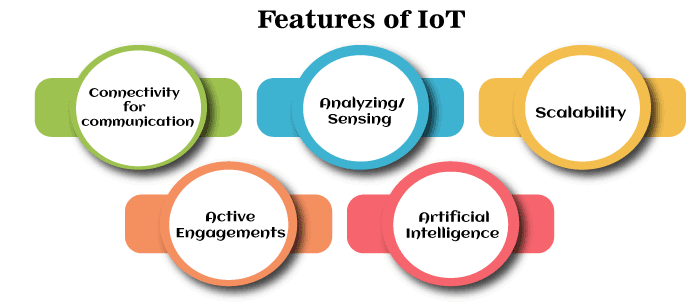
3) How does the IoT (Internet of Things) affect our everyday lives?IoT can make smart devices for our everyday lives. The devices embedded in IoT technology can manifest a greater quantum of automation than those available before. IoT can create a greater network that enables different devices to interact freely with each other and make our everyday lives better. IoT has a lot of positive effects on our daily life. For example, the IoT-enabled sensor-driven home appliances such as refrigerators automatically turn off when not in use or virtual assistants, which can regulate most of our devices from the lights used in our room to our television, air condition, or playing our favorite music, etc. IoT is not only limited to our gadgets. Even our wearables have evolved a lot with the use of IoT. Our smartwatches, sunglasses, earphones, and many more have the mark of IoT. If we talk about large-scale applications, the transportation industry, the government infrastructure, and educational initiatives are also hugely affected by IoT technology. According to a report by Garter, by 2020, approximately 20.6 billion devices will have IoT elements that connect them. 4) What industries can be benefitted from IoT?A wide range of industries can be benefitted from IoT. Some of them are as follows:
5) What are the different types of components used in IoT?There are usually four main components used in IoT devices: 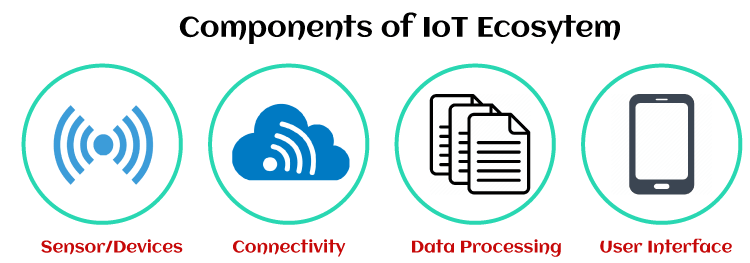
Sensors: Sensors are the most important part of IoT devices. In IoT devices, a sensor is used as an input device to gather live data from the surrounding environment. It can gather different types of data. For example, your phone has a temperature sensor, a GPS, an accelerometer, or a live video feature on a social media platform. Sensors make it possible for IoT devices to connect to the real world and outside the environment. This is all possible because of sensors. Connectivity Mediums: After gathering data from the sensors, all data is sent to a cloud infrastructure. This is possible because of connecting the sensors to the cloud using a variety of communication mediums such as mobile or satellite networks, Bluetooth, WI-FI, WAN, etc. There are various types of IoT devices, and they use different types of connectivity mediums for communication. Data Processing: Data Processing: The data processing compound comes into play when the data has been collected and has reached the cloud. Now, it is the responsibility of the data processors to process the data for further use. Data processing software is required to enhance IoT devices in several ways. For example, it can adjust the air conditioner's temperature or recognize the faces on mobile phones and so on. User Interface: The IoT devices require a user interface to interact with a user. A user interface is the visible, tangible component of an IoT system that users can access. It makes the information presentable and valuable for the end-user. A well-designed user interface can enrich the experience for users and encourage them to interact more. It makes the information easy and accessible to end-users, like sending alerts via notification, email, or text message. 6) What is Raspberry Pi?The Raspberry Pi is a small-sized (a credit card sized), low-cost computer that can be plugged into a computer monitor or TV and used with a standard keyboard and mouse. It can do all the operations like a conventional computer. It provides additional features such as onboard WIFI, GPIO pins, and Bluetooth to communicate with external electronic devices. 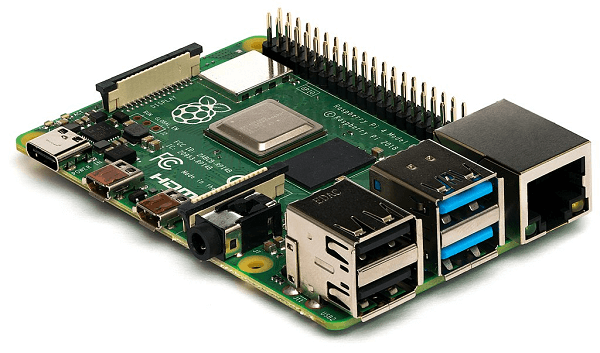
7) What are the key advantages of IoT?IoT devices are a complete package of advanced automation and analytics system that makes use of networking, big data, sensing, and Artificial Intelligence to provide a complete solution. Following are the key advantages or benefits of IoT: 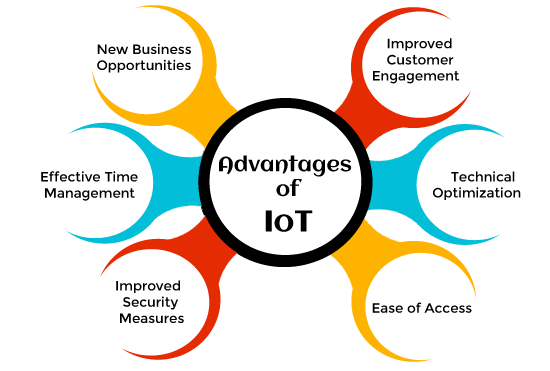
Better customer experience: IoT devices provide a better customer experience by automating tasks. For example, an IoT-enabled electronic device automatically detects any issue by its sensors and can notify its user. Ease of Access: IoT devices use sensors to access real-time information from any location or environment. It just requires a smart device connected to the internet. Technical optimization: IoT devices use improved technology, making them more efficient. It can make even old "dumb" devices into "smart" ones by making them capable of transmitting data over the internet and facilitating communication with people and other IoT-enabled devices. For example, washing machines, coffee machines, smart toys, smart microwaves can act smart with IoT. Efficient Resource Management: Usually, we rely on superficial insights to make decisions, but IoT devices provide real-time insights that facilitate us to do efficient resource management. Effective Time Management: This is one of the biggest advantages of IoT. It can save a lot of time. For example, you can operate your household devices at your fingertip. While commuting to work, you can read the latest news on your phones, online shopping, browse a blog about your favorite hobby, etc. Improved security: IoT provides additional security to organizations and individuals as they can access and lock their things on their phones. For example, by using IoT technology in surveillance, we can increase an organization's security standards and identify any suspicious activity on our phones. Create new business opportunities: IoT devices can create new business insights and generate new opportunities and reduce operational costs. 8) What are the different types of sensors used in IoT?Sensors are the most important components used in IoT devices. Sensors are important because they are the input devices that detect changes in the environment condition and act accordingly. In the physical world, sensors are used to detect specific conditions such as heat, light, sound, distance, pressure, presence or absence of gas/liquid, etc., and then generate an electrical signal after measuring their magnitude. In recent years, IoT sensors have evolved in a great way to enhance productivity, lowering costs, and improve worker safety. Following are the most commonly used sensors in IoT systems:
9) What are the biggest challenges or risks associated with IoT?Following is the list of biggest challenges or security risks associated with IoT: 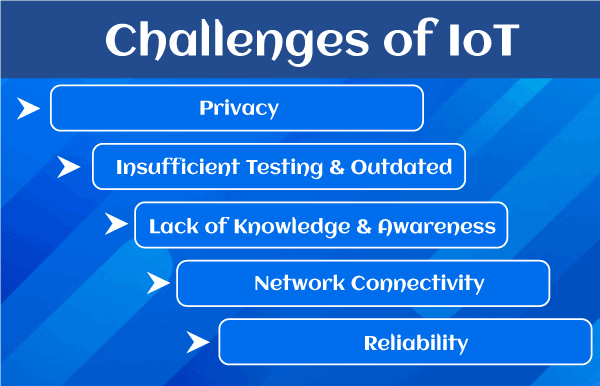
Privacy: With IoT devices, you will always be concerned regarding data security and privacy. IoT devices are a setup of many connected devices vulnerable to hacking. Many IoT devices collect and transmit personal data over an open network without encryption that may be easy for hackers to access. Hackers may also use cloud endpoints to attack servers. Reliability: IoT devices have a highly distributed nature. That's why it is difficult to ensure the reliability of IoT systems. Several conditions can affect the components of IoT systems, such as natural disasters, disruptions in cloud services, power outages, and system failures. Network Connectivity and Control: Network connectivity is a must for IoT devices, but sometimes, it may be challenging, particularly if the connected devices are widely dispersed in remote locations or if bandwidth is severely limited. Constant and Continuous Power Supply: IoT devices require a constant and continuous power supply to act properly. It may not be easy in some cases. Insufficient testing and updating: The market of IoT is very new and fast-paced. Many companies or manufacturers rush to start releasing their products and software without doing enough testing and proper updating. Many of them don't provide timely updates, leaving them vulnerable to data theft. IoT devices should be tested thoroughly and updated as soon as new vulnerabilities are identified to maintain security and win customers' trust. Lack of knowledge and awareness: IoT is a very new and growing technology, so; people do not have proper knowledge or awareness about these devices. It may also act as a security threat to users' confidentiality. 10) What is PWM or Pulse Width Modulation?PWM is an acronym that stands for Pulse Width Modulation. It is an analog signal that varies the amount of time when the signal is high. The signal can be high or low, and the user can modify the time proportion. 11) What are the different layers of the IoT protocol stack, and why are they used?IoT protocols are the ways to protect data and ensure it to be exchanged securely between devices via the Internet. IoT protocols define how data is transmitted across the Internet and ensure that the data exchanged between connected IoT devices is secure anyway. Different communication layers and their respective IoT protocols:
12) What are the key differences between IoT and IIoT?The key differences between IoT and IIoT are as follow:
13) What is Arduino used in IoT?Arduino is a free electronics platform that provides easy-to-use hardware and software. It is used in IoT as it has a microcontroller that reads input from the sensors and controls the device according to the written program. 14) What are the different types of communication models used in IoT?IoT devices must be connected to the internet to work properly. These devices connect and communicate through their technical communication models. There are several ways to connect them to the internet for communication. An effective communication model is required for proper communication. Following is a list of different types of communication models used in IoT: Request-Response Communication Model 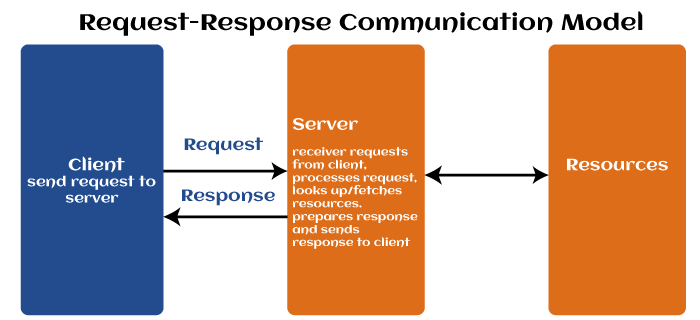
As the name specifies, the request-response communication model is based on the client making requests and the server responding to those requests. When the server receives a request, it decides what response to be provided. It fetches the requested data, prepares the response, and then sends it back to the client. This model does not retain the data between requests; therefore, each request is handled independently. That's why this is called a stateless model. Publisher-Subscriber Communication Model 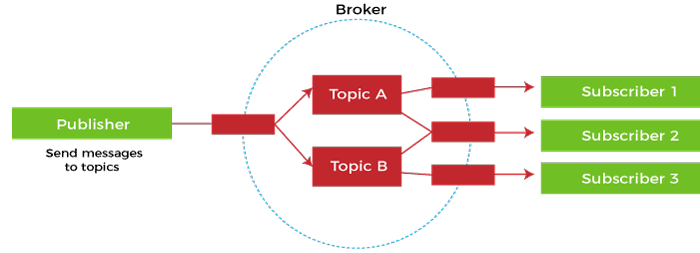
In this communication model, publishers, brokers, and consumers are all involved in communication. Publishes are used as sources of data that send data to topics. The broker manages the topics, and consumers subscribe to the topics. Publishers and consumers are not directly related to each other. When the publisher receives the data for a topic, the broker forwards it to all subscribed consumers. It means brokers are responsible for receiving data from publishers and sending it to the appropriate consumers. Push-Pull Communication Model 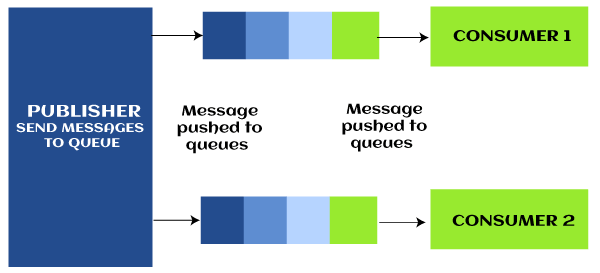
The push-pull communication model ensures that data producers push the data into queues while consumers pull the data from the queues. In this communication model, neither producer nor consumer knows about each other, and it is the responsibility of the queue to decouple the messages between the consumers and the producers. Here, queues also act as a buffer if any mismatch is found between the rate at which producers push data and the rate at which consumers receive it. Exclusive-Pair Model 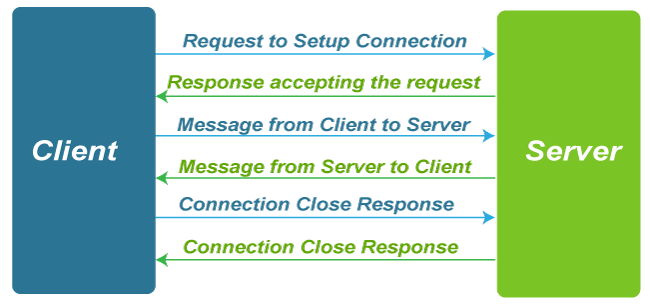
This is the most efficient model for quick communication. This is a full-duplex, bidirectional communication model developed for constant/continuous connections between a client and server. Once a connection is established, the clients and the servers can send and receive messages. As long as a client doesn't send a request to close the connection, the connection remains open. The server takes care of every open connection. 15) What is the basic difference between an IoT device and a normal sensor device?A normal sensor device does not need an active internet connection to work properly. On the other hand, IoT devices always require an active internet connection to work properly. 16) What is the Bluegiga APX4 protocol?The Bluegiga APX4 protocol is a solution based on a 450MHz ARM9 processor. It is used for communication in IoT devices as it supports both the WIFI and BLE platform. 17) What are some of the most common real-world applications of IoT?IoT can solve many real-life problems. Following is a list of some most common real-world applications of IoT: Smart Homes: The most common and practical real-life application of IoT is smart homes. We can apply IoT in smart homes at various levels, but intelligent systems and entertainment are the best and most common use. For example, smart door lock, automatic lighting system, automatic air-conditioning, and smart set-top box facilitate you to record shows from anywhere, etc. Wearable devices: Wearable devices are also great examples of IoT. Nowadays, the young generation uses many IoT-enabled wearable devices like Fit Bits, heart rate monitors, smartwatches, etc. This field has emerged as a very profitable business industry. Connected Health System: Connected health systems can be used to monitor critical patients. IoT can also improve the power, precision, and availability of current devices used in the medical field. It provides real-time monitoring and patient care to be used in better medical decisions. Internet-Connected Vehicles: Internet-connected vehicles use internet connectivity and onboard sensors to provide better operation, maintenance, and comfort to the passengers. The leading automobile companies like Tesla, BMW, Apple, and Google are working on IoT to revolutionize the automobile industry. Agriculture and Farming: IoT can also be very useful in agriculture and farming. Using IoT, we can develop tools for drip irrigation, understanding the crop patterns, water distribution, drones for farm surveillance, etc. Farmers can increase the yields by using IoT tools and methods. Hotels and Hospitality Industry: IoT can provide higher service quality to the hotel and hospitality industry. IoT-enabled integrated applications can manage several activities such as tracking guests' locations, sending them attractive offers, placing orders for room service, automatically charging the room account, etc. Using IoT, we can automate many things in hotels and achieve a higher level of service quality. 18) Explain the working of IoT?IoT is based on Artificial Intelligence. The basic technology used in IoT devices is Artificial Intelligence. IoT contains multiple components like sensors, cloud components, data processing software, cutting-edge user interfaces, etc. In IoT systems, sensors connect the devices to the cloud. It uses Raspberry Pi equipped with a quad-core processor used as an "Internet gateway" for IoT devices. Raspberry Pi is a card-sized computer that controls outputs with GIPO (general purpose input/output) pins. It collects data about real-world conditions using sensors. Sensors collect live data from the surrounding environment and send it to a cloud infrastructure. When the cloud receives the data, the software can process it and decide what action to take, such as sending an alert or automatically adjusting the sensors/devices without user intervention. A user interface is required to check if user input is required or if they want to check in on the system. The user's adjustments are then sent inversely through the system to the cloud and from the cloud back to the sensors/devices to make changes. As a result, it thoroughly creates a highly reactive and intuitive device which increases the automation of the device. 19) Why is PWM used in IoT?PWM stands for Pulse Width Modulation. In IoT, Pulse Width Modulation is mainly used to control the speed of the DC motor, control the direction of a servo motor, dim the LED, etc. 20) What are the various wireless communications boards available in Raspberry Pi?There are mainly two wireless communications boards available in Raspberry Pi:
21) What do you understand by the thermocouple sensor?A thermocouple sensor is a specific type of sensor used to measure temperature by coupling two metal pieces together. These two pieces of metal are joined at one end, and the temperature is measured at a junction. A small voltage is generated by the metal conductors, which is interpreted to calculate the temperature. A thermocouple is a simple, robust, and economical temperature sensing device available in multiple types and sizes. The thermocouple sensor can measure a wide temperature range, which makes it suitable for various applications, such as scientific research, industrial settings, home appliances, etc. 22) What functions are used to read analog and digital data from a sensor in Arduino?There are two functions used to read analog and digital data from a sensor in Arduino:
23) What is Shodan in IoT?Shodan is an acronym for Sentient Hyper-Optimized Data Access Network. Like Google, it is a search engine, but it does not search for websites. Instead, Shodan is an IoT search engine used for mapping and providing information about internet-connected devices/systems. In other words, we can say that Shodan is an IoT tool used to identify Internet-connected devices and keep tracking of all the machines with direct Internet access. Cybersecurity experts use the Shodan tool to protect individuals, companies, and public utilities against cyber-attacks. On Shodan, you can search for any internet-connected device and check if it is publicly available or not. 24) What are the different available models in Raspberry Pi used in IoT?The different available models in Raspberry Pi used in IoT are:
25) What are some most suitable databases for IoT?Following is a list of some most suitable databases for IoT:
26) What is MicroPython?MicroPython is a Python implementation with a small subset of its standard library. We can optimize and run it on the ModeMCU microcontroller. 27) What do you understand by sharding?Sharding is the process of splitting a huge database into smaller, faster, and manageable pieces, called data shards. A shard is a small part of a large data set. Sharding is mainly used to split a logical dataset into multiple databases to make them store more efficiently. It is necessary in the case of a dataset that cannot be stored in a single database. |
You may also like:
- Java Interview Questions
- SQL Interview Questions
- Python Interview Questions
- JavaScript Interview Questions
- Angular Interview Questions
- Selenium Interview Questions
- Spring Boot Interview Questions
- HR Interview Questions
- C Programming Interview Questions
- C++ Interview Questions
- Data Structure Interview Questions
- DBMS Interview Questions
- HTML Interview Questions
- IAS Interview Questions
- Manual Testing Interview Questions
- OOPs Interview Questions
- .Net Interview Questions
- C# Interview Questions
- ReactJS Interview Questions
- Networking Interview Questions
- PHP Interview Questions
- CSS Interview Questions
- Node.js Interview Questions
- Spring Interview Questions
- Hibernate Interview Questions
- AWS Interview Questions
- Accounting Interview Questions







